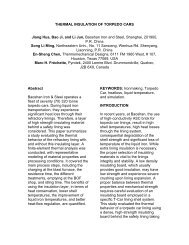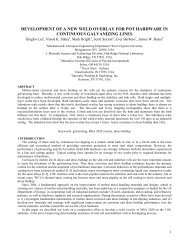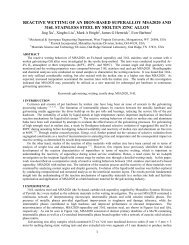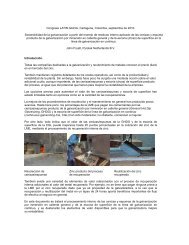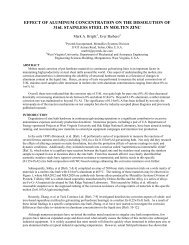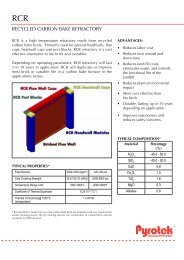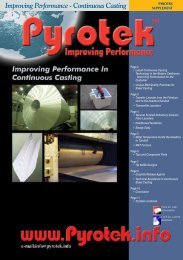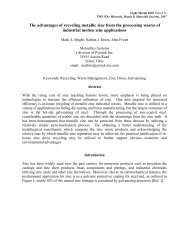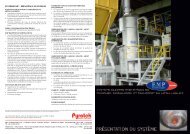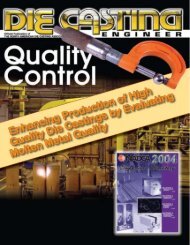improving performance in furnace melt treatment process - Pyrotek
improving performance in furnace melt treatment process - Pyrotek
improving performance in furnace melt treatment process - Pyrotek
Create successful ePaper yourself
Turn your PDF publications into a flip-book with our unique Google optimized e-Paper software.
Jonathan Prebble,<br />
<strong>Pyrotek</strong>’s Manager of<br />
Alum<strong>in</strong>ium Process<br />
Technology<br />
In-Furnace Melt Treatment Process<br />
<strong>Pyrotek</strong> has<br />
the expertise,<br />
technology,<br />
experience<br />
and the<br />
global<br />
resources to<br />
maximize the<br />
<strong>performance</strong><br />
of your<br />
alum<strong>in</strong>ium<br />
<strong>melt</strong><br />
<strong>treatment</strong><br />
systems.<br />
Page 2<br />
PYROTEK<br />
SUPPLEMENT<br />
IMPROVING PERFORMANCE IN<br />
FURNACE MELT TREATMENT PROCESS<br />
ANALYZING THE MELT<br />
TREATMENT PROCESS<br />
Quality is generally def<strong>in</strong>ed as<br />
conformance to mutually agreed upon<br />
customer specifications. This def<strong>in</strong>ition<br />
matches well with any discussion around<br />
alum<strong>in</strong>ium <strong>melt</strong> quality and the related<br />
molten metal <strong>treatment</strong> <strong>process</strong>. The <strong>melt</strong><br />
<strong>treatment</strong> <strong>process</strong>es addressed <strong>in</strong> this<br />
article <strong>in</strong>clude alloy<strong>in</strong>g and <strong>furnace</strong> <strong>melt</strong><br />
ref<strong>in</strong><strong>in</strong>g. In-l<strong>in</strong>e degass<strong>in</strong>g and filtration,<br />
which are important components <strong>in</strong><br />
achiev<strong>in</strong>g f<strong>in</strong>al <strong>melt</strong> quality, will be<br />
addressed separately <strong>in</strong> the next article <strong>in</strong><br />
this series titled, “Improv<strong>in</strong>g Performance –<br />
Degass<strong>in</strong>g and Filtration Processes.”<br />
The five ma<strong>in</strong> <strong>melt</strong> quality culprits for the<br />
casthouse are the follow<strong>in</strong>g:<br />
Trace elements, caus<strong>in</strong>g off specification<br />
or <strong>in</strong>consistent casts.<br />
Alkali metals, caus<strong>in</strong>g crack<strong>in</strong>g and<br />
missed specifications.<br />
Hydrogen, caus<strong>in</strong>g porosity and density<br />
compla<strong>in</strong>ts.<br />
Inclusions, caus<strong>in</strong>g downstream<br />
<strong>process</strong><strong>in</strong>g complications.<br />
Product <strong>in</strong>consistency due to either<br />
chemical or thermal variations dur<strong>in</strong>g<br />
cast<strong>in</strong>g.<br />
The <strong>process</strong> of <strong>melt</strong> <strong>treatment</strong> starts with the<br />
requirements of the f<strong>in</strong>ished product’s enduser.<br />
These requirements vary widely and<br />
need to be understood, agreed upon and<br />
documented so that <strong>melt</strong> quality <strong>process</strong>es<br />
can be managed to deliver this specification<br />
with zero defects at the lowest possible<br />
cost. While it starts with consistently<br />
meet<strong>in</strong>g customer specifications, it does not<br />
end there. Other critical factors <strong>in</strong> manag<strong>in</strong>g<br />
<strong>melt</strong> quality <strong>process</strong>es <strong>in</strong>clude operational<br />
costs/cycle times, operational health and<br />
safety, and environmental impact/<br />
compliance.<br />
To maximize casthouse <strong>performance</strong> <strong>in</strong> all<br />
these critical areas, it is important that the<br />
production team clearly understands the<br />
market<strong>in</strong>g and operational objectives<br />
<strong>in</strong>volved. These def<strong>in</strong>ed objectives measure<br />
the effectiveness of the <strong>melt</strong> quality<br />
<strong>process</strong>es and practices upon the f<strong>in</strong>al cast<br />
product. Typical challenges <strong>in</strong>clude, but are<br />
not limited to, how to achieve the same<br />
level of product quality consistency time <strong>in</strong><br />
and time out, comb<strong>in</strong>ed with how to achieve<br />
optimum <strong>performance</strong> <strong>in</strong> a practical<br />
manner while, at the same time, m<strong>in</strong>imiz<strong>in</strong>g<br />
costs and maximiz<strong>in</strong>g productivity.<br />
These challenges and issues vary greatly<br />
depend<strong>in</strong>g upon whether <strong>process</strong><strong>in</strong>g<br />
primary or secondary metals. It is important<br />
to understand the <strong>melt</strong> quality and source<br />
of impurities at the beg<strong>in</strong>n<strong>in</strong>g of the cast<strong>in</strong>g<br />
<strong>process</strong> <strong>in</strong> order to establish successful<br />
operational <strong>process</strong>es that will deliver<br />
consistent metal quality to the cast<strong>in</strong>g<br />
station.<br />
<strong>Pyrotek</strong>’s mission is to work with casthouse<br />
managers to develop a coord<strong>in</strong>ated, holistic<br />
approach to a susta<strong>in</strong>able operations plan<br />
for <strong>melt</strong> <strong>treatment</strong>. We br<strong>in</strong>g all these<br />
operational elements together <strong>in</strong> a<br />
synergistic way that maximizes the<br />
<strong>performance</strong> of each step of the <strong>melt</strong><br />
<strong>treatment</strong> <strong>process</strong>. <strong>Pyrotek</strong>’s approach<br />
<strong>in</strong>cludes a <strong>process</strong> audit and situation<br />
analysis with the customer to jo<strong>in</strong>tly<br />
understand and document the customer’s<br />
operational objectives, historical operat<strong>in</strong>g<br />
<strong>performance</strong>, cast<strong>in</strong>g pit capabilities, end<br />
user requirements, environmental<br />
objectives and safety. Once these are<br />
understood and agreed upon, a prioritized<br />
list of <strong>performance</strong> improvement projects<br />
(PIP’s) are identified. A <strong>Pyrotek</strong> technical<br />
team is then organized to work with the<br />
customer to execute, track and evaluate<br />
each project’s results aga<strong>in</strong>st preestablished<br />
targets and world-class<br />
operational norms for similar operations,<br />
target<strong>in</strong>g similar <strong>melt</strong> quality specifications.





